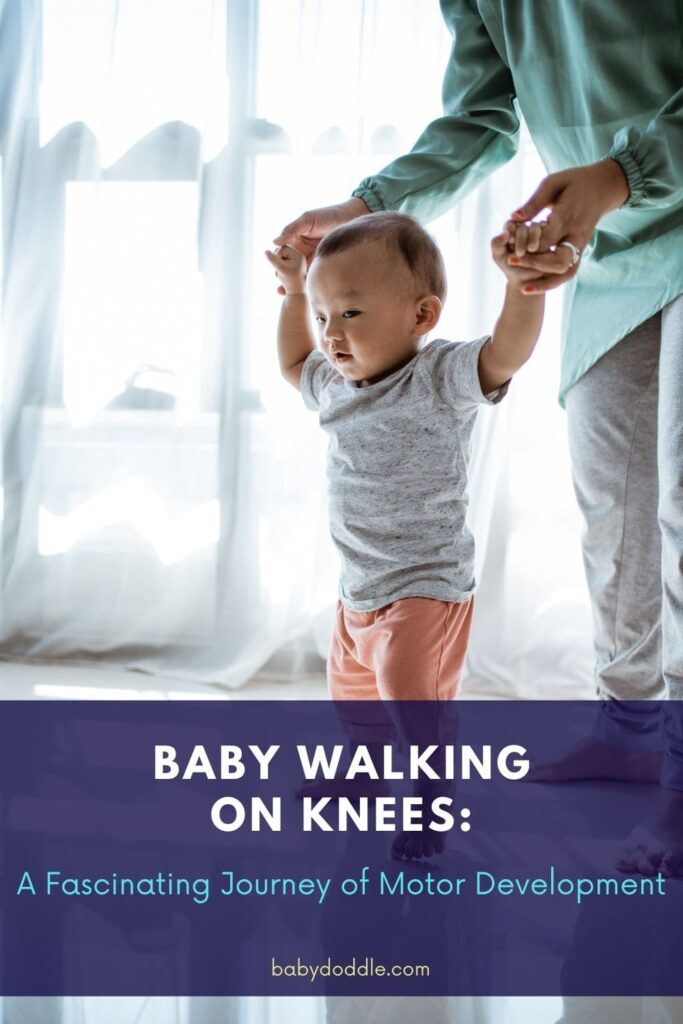As a parent, watching your little one grow and hit key milestones is an incredible experience. One of the most exciting achievements is when your baby starts to walk! But did you know that before taking those first wobbly steps on their feet, many babies go through an intermediate “baby walking on knees“ phase?
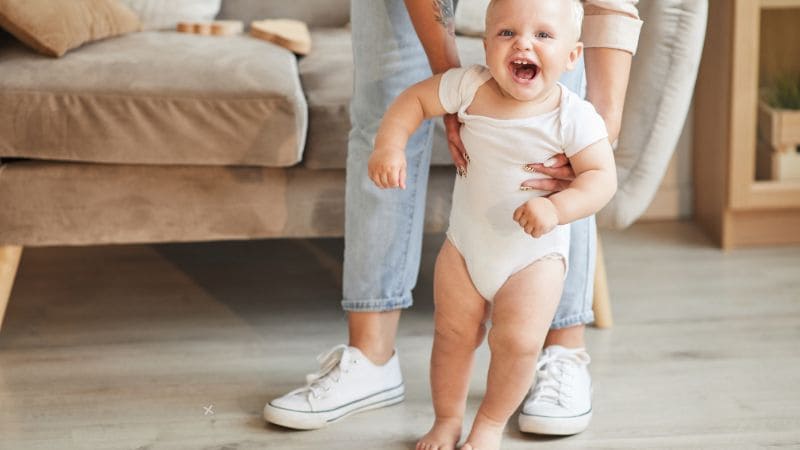
What is Knee Walking?
Knee walking refers to the stage where a baby crawls or moves around on their knees instead of their hands and feet. Rather than a traditional crawl position with hands planted on the floor, babies doing knee walking will shuffle about on their knees with their back, neck, and head upright. This important developmental phase typically emerges between 9 and 12 months as toddlers build confidence and balance.
Knee walking allows babies to strengthen key muscle groups like their hips, legs, and core which are necessary for eventual upright walking. It indicates your little one is starting to shift weight and find stability on their knees in preparation for standing unsupported. While every baby develops on their own timeline, going through a knee walking period first is very common.
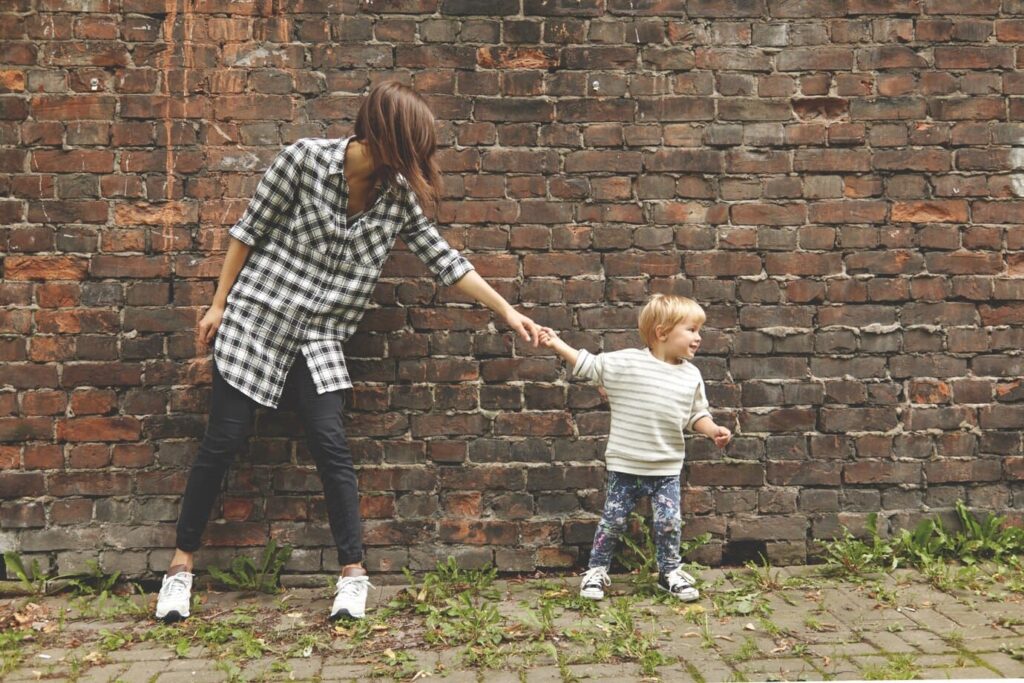
The Benefits of Baby Walking on Knees Stage
Allowing your baby to explore knee walking offers physical and neurological advantages including:
- Building leg and hip strength: Having to support themselves upright on their knees bolsters key muscle development. Their quadriceps, glutes, hamstrings, and hip abductors get a great workout!
- Improving balance and coordination: Keeping their torso upright while shuffling along challenges their equilibrium and coordination in ways regular crawling does not.
- Developing core stability: Having to keep their back straight while knee walking strengthens the baby’s core and trunk muscles.
- Learning to shift weight: Transferring weight side to side from knee to knee sets the foundation for walking mechanics.
- Boosting confidence: Mastering a new form of mobility gives babies independence which stimulates self-assurance.
- Enhancing spatial awareness: Upright knee walking allows babies to view surroundings from a new vantage point.
- Preparing the spine: Spinal strengthening and alignment occur, getting the baby’s back ready to eventually support more weight.
So while a baby walking on knees may seem unusual, it actually offers babies many developmental upsides! Of course, speak to your pediatrician if you have any concerns.
Timeframes for Baby Walking on Knees
Every infant has their own personalized timeline when it comes to physical milestones. While some babies skip knee walking altogether, many go through a 2 to 3-month knee walking phase. Signs your little one is ready to start ambling about on their knees include:
- Rocking back and forth on hands and knees
- Pulling themselves up on furniture
- Brief kneeling without support
- Attempting simple kneeling steps
Around the 8 to 9-month mark, if your baby already crawls efficiently or cruises around furniture walking, their muscles may be prepared for knee walking. By providing encouragement through toys, they’ll likely shuffle their first knee walks soon after building readiness skills.
| Milestone | Average Age Range | Signals Child is Ready |
|---|---|---|
| Rocking/crawling | 6-10 months | Balancing on hands and knees, crawling efficiently |
| Knee scooting | 8-12 months | Sitting upright unsupported, minimal crawling |
| Classic knee walking | 9-12 months | Pulling to stand at furniture, cruising steps |
| Upright cruising | 10-15 months | Walking holding one hand, standing briefly alone |
| Independent walking | 9-18 months | Walking holding one hand, standing 10+ seconds alone |
Common Concerns About Baby Walking on Knees
It’s natural for parents to have some worries when babies start ambulating in an unconventional kneeling position. Here are some common concerns and reassurance:
Bruising or Discomfort – It’s normal for some temporary redness or irritation as their knees adjust to bearing weight. Use soft kneepads or pants to prevent bruising. If actual pain occurs, reduce knee walking time and consult your pediatrician.
Early Walking – While every baby has their own timeline, knee walking typically occurs between 9-12 months as they build readiness for upright walking. If it emerges significantly sooner, discuss with your doctor.
Delayed Walking – If your baby is over 12 months and not knee walking yet, don’t worry. Some skip knee walking altogether and go straight to pulling up and cruising. Consult your pediatrician if you have concerns.
Comparison with Others – Avoid stressing if your baby isn’t knee walking as soon as a friend or sibling did. All babies develop on their own schedule. Focus on their personal progress.
Have faith in the process! Knee walking is a natural phase that builds strength at their own pace. If significant pain, falling, or other issues occur, do reach out to your pediatrician for personalized guidance.
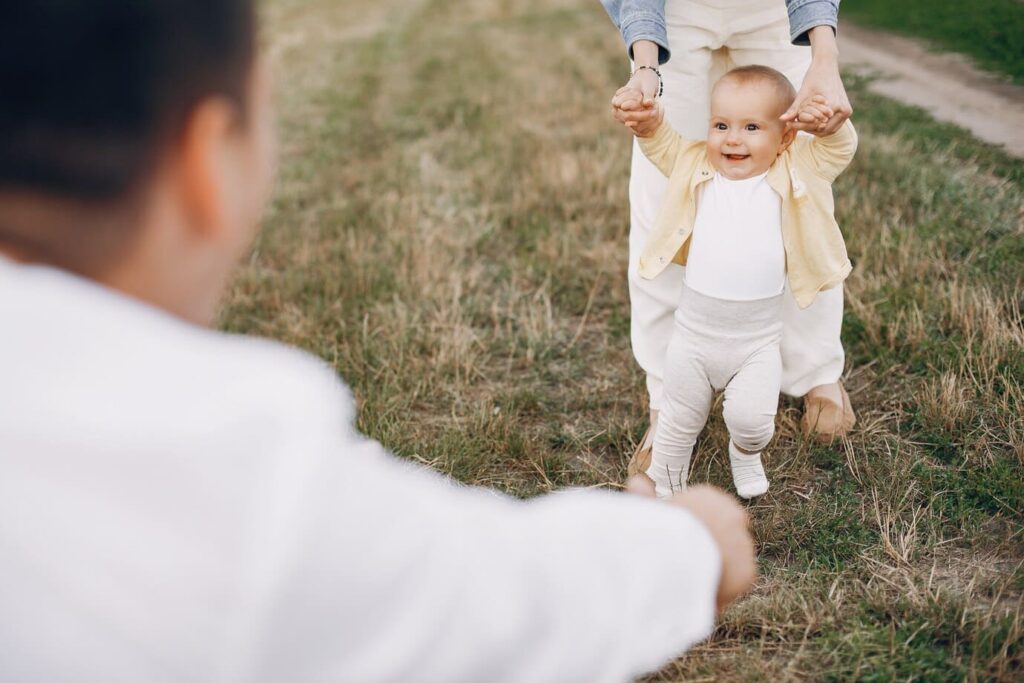
Helping Your Knee Walker
Once knee walking begins, there are plenty of ways to make the learning process safe and fun including:
Appropriate Floor Surfaces
- Carpets and rugs – soft landing!
- Rubber mats or foam pads
- Avoid hardwood or tile floors
Protective Gear
- Baby knee pads or soft leg warmers
- Socks with grippy tread
- Well-fit, flexible pants
Supportive Toys
- Push or pull toys they can use handles while knee walking
- Low ride-on toys for resting breaks
Positive Encouragement
- Give applause and praise for progress
- Avoid pressure or comparison with others
- Patience is key – let them set the pace
If you ever have concerns about a baby’s development, check in with their pediatrician for expert guidance. But in most cases, allowing them to knee walk builds important abilities – and is downright cute!
| Area | Preparation Tips |
|---|---|
| Safety | Childproof home, install gates, cover sharp edges |
| Flooring | Use soft carpets, rugs, mats for knee comfort |
| Clothing | Use non-slip socks, flexible pants, knee pads |
| Toys | Push/pull toys, ride-ons for breaks |
| Support | Clear wide pathways, graspable furniture |
| Encouragement | Smiles, praise for attempts to build confidence |
Exercises and Stretches for Knee Walking Muscles
Supplement knee walking practice with targeted exercises:
- Hip abduction stretches – Bring bent knees out to sides
- Knee extension – Laying down, straighten knees
- Ankle stretches – Flex feet up and down
- Tummy time – Strengthens back and neck
- Supported standing – at furniture, build leg endurance
- Balance activities – Shift weight side to side on knees
Check with your pediatrician before beginning any baby exercises or stretches. Tailor activities to their abilities.
Preparing Home Environment for Knee Walking
As your baby embarks on knee walking, make your home environment safe:
- Install safety gates at staircases, kitchens, or any dangerous areas.
- Ensure potential choking hazards are contained.
- Tuck away loose wires, cords, or trip risks.
- Cover sharp corners of furniture or coffee tables.
- Clear open pathways through main rooms free of clutter.
- Provide graspable supports like ottomans or benches at various heights.
- Designate a padded, obstacle-free play space for knee walking practice.
Taking these babyproofing steps lets your little one explore safely as their mobility increases.
Fun Floor Activities for Knee Walking Babies
Knee walking practice can be playtime! Set up engaging activities to make it entertaining:
- Make an indoor mini obstacle course with cushions to crawl over, tunnels to crawl through, and pillow ramps.
- Get popup peekaboo toys they can push down and knee walk into, building curiosity.
- Arrange toys at different distances to encourage knee walking from one to the next across the room.
- Place toys on both sides to motivate lateral knee walking side to side strengthening hips.
- Add variety of textures like shag carpet squares, foam mats, soft rugs so they experience new sensations.
- Use ball pits or soft blocks they can knee walk over and explore.
- Read books while they knee crawl into your lap developing coordination.
Finding creative ways to practice makes mastering knee walking fun!
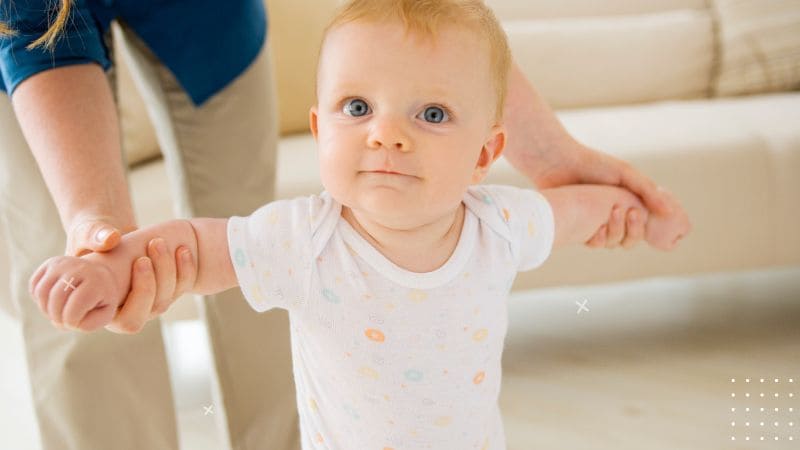
When Upright Walking Emerges
Independent walking on their feet usually follows a few months after a baby’s knee walking adventures begin, between 9 and 18 months old. Signs your little one will start standing and stepping solo include:
- Cruising laps around furniture easily
- Standing unsupported for over 10 seconds
- Bending in half or squatting while holding onto something
- Walking confidently while holding just one hand
When those signals appear, the baby is showing bodily preparedness for the balance and coordination involved in upright ambulation. By allowing them unassisted standing and cruising practice, you fuel their readiness to take independent steps.
Here are some tips for furthering progress:
- Clear wide walkways and childproof dangers
- Arrange graspable supports at various heights
- Place enticing toys just out of reach
- Use backpacks, plush toys, or shopping carts for stability
- React encouragingly to any attempts to step
Avoid discouraging behaviors like walkers or bouncers which bypass physical practice baby needs. Have faith that your little one will walk when their body and brain decide the time is right!
Developmental Milestones Before and After Knee Walking
Knee walking does not emerge overnight. It builds on other skills babies gain leading up to it:
- 2-4 months: Rolling, lifting head upright when on tummy
- 4-6 months: Sitting independently, bearing weight on legs when held
- 6-10 months: Rocking on hands and knees, crawling efficiently
Mastering knee walking then sets the stage for upcoming milestones:
- 10-15 months: Cruising while holding onto furniture
- 12-18 months: Standing unassisted for extended time
- 9-18 months: Taking first independent steps
So knee walking is an important bridge between early mobility milestones like crawling and later skills like walking upright.
Signs Knee Walking is Transitioning to Upright Steps
How do you know when your knee walker is gearing up to stand and walk? Look for:
- Standing unassisted holding onto furniture for longer stretches.
- Cruising laps easily around safety gates or coffee tables.
- Walking steadily forward holding just one hand for balance.
- Squatting or bending in half while stabilized showing balance.
- Making first shaky attempts at solo steps between supports.
These signals indicate their strength and coordination are preparing for upright walking independence! Continue providing safe opportunities to stand and cruise at their own pace.
Knee Walking Tips for Parents
Making the most of this special stage:
- Stay patient – Avoid pressure or comparison with other babies
- Prioritize safety – Childproof home, provide padding
- Let them lead – Allow to set their own knee walking pace
- Offer variety – Novel toys and activities maintain interest
- Give praise – Applaud small accomplishments along the way
- Have fun! – Get on floor and interact during practice
With encouragement and the right conditions, knee walking strengthens key skills at their own tempo.
Final Thoughts
Witnessing your baby transform from an immobile infant into a knee-crawling explorer and finally an upright walker is an amazing privilege. As parents, we get to nurture their development through an exciting continuum of mobility milestones.
Knee walking is a common stop along that fascinating journey which builds strength, balance, and confidence babies need for their next achievement – walking on two feet! By understanding this important phase of baby walking on knees and providing a safe environment for physical discovery, we help pave the way towards this ultimate independence milestone.
FAQs- Baby Walking On Knees
Is it normal for babies to walk on their knees?
Yes, it is completely normal and common for babies to go through a stage of walking or crawling on their knees around 9-12 months as they build up walking skills. It indicates strengthening leg muscles and balance. Most babies knee walk for 2-3 months before walking upright.
What are some benefits of baby walking on knees?
Key benefits of knee walking include building leg strength, improving balance/coordination, developing core stability, learning to shift weight between sides, boosting confidence through new mobility skills, and more.
How can I encourage safe knee walking at home?
Use carpeted floors or rubber mats to soften falls. Consider protective baby knee pads. Provide push/pull toys babies can use for support while knee walking. Monitor closely and positively praise efforts.
At what age do babies typically walk independently?
Independent, upright walking without support typically emerges between 9-18 months old, usually a few months after a baby begins exploring knee walking. Signs of readiness include cruising furniture easily, standing briefly alone, and walking confidently with minimal hand-holding.
How can I help my baby transition from knee walking to upright walking?
Encourage unassisted standing/cruising, clear wide walkways, provide different height grab bars, place motivating toys out of reach, use push toys for stability, and positively reinforce all attempts to progress walking skills. Avoid baby walkers.
At what age do most babies start knee walking?
Most babies begin knee walking between 9 and 12 months of age. However, every child develops at their own pace. Some may start knee shuffling as early as 8 months, while others may skip crawling and go straight to pulling up and cruising furniture. Knee walking typically emerges once a baby has developed adequate trunk strength and balance from activities like rocking on hands and knees. If your baby is over 12 months and not knee walking, consult your pediatrician. But in general, anytime from 8 to 12 months is common for this important strengthening phase.
Is it necessary for babies to go through a knee walking stage before walking?
While some babies skip knee walking, going through this transitional stage is very common and provides many physical benefits. Shuffling on their knees bolsters muscle development in their hips, legs and core which aids coordination for upright walking. Knee walking also helps babies learn to shift weight side to side and improve balance control. So while not absolutely required, allowing a period of knee ambulation helps prepare their bodies for the demands of independent walking.
My baby seems frustrated trying to knee walk. Should I be concerned?
It’s natural for babies to feel some initial frustration mastering a new physical skill like knee walking. You may see fussiness, hesitation or signs your little one is thinking hard to coordinate the new motions. Praise attempts to boost their confidence, but avoid pressure. Allow them to knee crawl at their own pace without comparing them to others. If you have concerns about severe pain or falling, consult your pediatrician. But in most cases, give them time to gain strength and balance through practice. Their frustration will turn to motivation and pride as their skills improve.
How can I encourage knee walking practice safely at home?
There are many ways to promote knee walking skill development at home. Childproof any dangers like stairs or sharp table edges. Designate a safe, clutter-free play space with soft carpeting, rugs or rubber mats for their knees. Use safety gates to contain them away from off-limit areas. Provide lots of graspable supports like ottomans or push toys at their height to aid balance. Offer toys just out of reach to motivate movement between supports. Get on the floor and interact face-to-face as they explore. And avoid infant equipment that could discourage muscle-building practice. With the right setup, knee walking practice can be playtime!
When will my baby transition from knee walking to real steps?
Most babies begin transitioning from knee ambulation to upright cruising and walking between 10 and 15 months. Signs your little one is strengthening skills for independent steps include cruising easily while holding onto furniture, standing unassisted for over 10 seconds, and walking steadily forward while holding just one hand. Allow them plenty of safe practice standing and “walking” along supports at their own pace. Most babies take their first real steps without help sometime between 9 and 18 months once they’ve built adequate coordination through activities like knee walking. But remember, every child has their own unique timeline, so try not to compare. Focus on their personal development!
